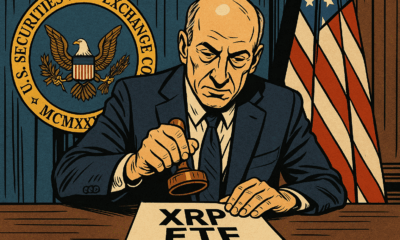News
Ripple’s Billion-Dollar Play: How RLUSD Could Enter the Heart of Corporate Finance

- Share
- Tweet /data/web/virtuals/383272/virtual/www/domains/theunhashed.com/wp-content/plugins/mvp-social-buttons/mvp-social-buttons.php on line 63
https://theunhashed.com/wp-content/uploads/2025/10/ripple_rlusd-1000x600.png&description=Ripple’s Billion-Dollar Play: How RLUSD Could Enter the Heart of Corporate Finance', 'pinterestShare', 'width=750,height=350'); return false;" title="Pin This Post">
When Ripple dropped a staggering $1 billion to acquire GTreasury, it wasn’t just another splashy headline in crypto finance. It was a strategic move aimed squarely at transforming the very structure of how corporate treasuries might operate in the future. At the core of this maneuver is RLUSD, Ripple’s U.S. dollar-backed stablecoin, which, until now, has been a relatively quiet player in a market dominated by the likes of USDC and USDT. With this acquisition, however, Ripple is constructing something far more ambitious than a payments network—it’s building a financial operating system for the enterprise world.
From Payments to Platform: Ripple’s Enterprise Evolution
Ripple has long positioned itself as the bridge between traditional finance and blockchain. With XRP serving as its volatile, liquidity-focused asset and RippleNet as the underlying infrastructure, the company carved out a niche in cross-border payments. But volatility and regulatory overhang limited XRP’s enterprise appeal.
Enter RLUSD, Ripple’s answer to stable, fiat-pegged liquidity. Unlike XRP, RLUSD doesn’t suffer from the same price unpredictability. But a stablecoin without distribution or embedded use cases is just another token on the shelf. That’s where GTreasury enters the picture.
GTreasury is a cornerstone in corporate cash management. Its platform helps Fortune 500 treasurers manage liquidity, automate financial operations, and ensure compliance across jurisdictions. By embedding RLUSD into this workflow, Ripple doesn’t just offer a new payment rail—it potentially transforms how CFOs manage cash, pay vendors, and move funds across the globe in real time.
The Integration Playbook: One Stack to Rule Them All
Ripple’s acquisition isn’t a standalone move. It’s part of a tightly orchestrated stack of recent deals that includes Hidden Road, a $1.25 billion acquisition of a prime brokerage firm, and Rail, a $200 million infrastructure provider focused on compliance and payments routing. Together, these pieces are more than the sum of their parts.
Through this trifecta, Ripple is crafting a vertically integrated enterprise platform. Corporate treasuries could, in theory, use GTreasury’s interface to move funds instantly via Rail’s compliance-friendly channels and settle in RLUSD, while Hidden Road offers capital efficiency through synthetic dollar liquidity and institutional brokerage services. It’s a closed-loop ecosystem where RLUSD is the default financial lubricant.
This is not simply about offering faster payments. It’s about building an entirely new framework for capital movement—one that never sleeps, never waits for bank hours, and never hesitates across borders.
Can RLUSD Break Into the Stablecoin Elite?
Despite this sophisticated architecture, RLUSD remains a fledgling stablecoin in a market dominated by heavyweights. Tether’s USDT still commands over half of the stablecoin market, with Circle’s USDC close behind, especially within regulated and enterprise contexts. RLUSD, while technically solid and backed by Ripple’s war chest, lacks the scale, trading pairs, and liquidity depth of its rivals.
However, what it lacks in market share it may gain in function. If Ripple can make RLUSD a native asset within treasury workflows—where it becomes the default medium for accounts payable, receivable, and cross-border settlements—it doesn’t need to compete head-to-head with USDT on volume. It would carve out a new, arguably more sustainable niche: enterprise utility.
That said, real traction depends on more than integration. Liquidity must be dependable. Corporate treasurers won’t adopt a token that becomes difficult to convert in scale. Ripple will need to ensure market-making partners and institutional liquidity providers can keep pace with demand.
A Conservative Audience, a Radical Idea
No group is more cautious with innovation than corporate treasurers. Their mandate is to preserve capital, ensure compliance, and manage risk—not to experiment with cutting-edge tools. For RLUSD to become more than a curiosity, Ripple must offer reliability, transparency, and seamless compatibility with existing regulatory frameworks.
This is where GTreasury’s existing reputation and infrastructure become crucial. Treasurers already trust the platform. If RLUSD becomes a toggle within the same interface they use daily, adoption becomes less a leap of faith and more a feature update. That is the bet Ripple is making.
Still, regulatory uncertainty looms large. Although U.S. legislators have introduced stablecoin frameworks such as the GENIUS Act, the global regulatory picture is fragmented. Europe’s MiCA, Asia’s divergent regulations, and the ever-evolving U.S. environment all add friction to widespread adoption. Ripple’s compliance stack, bolstered by Rail, aims to navigate this complexity—but it’s not a guarantee.
Competitive Friction: Ripple Is Not Alone
Ripple isn’t the only player eyeing enterprise stablecoin adoption. Circle is also actively pursuing partnerships with fintech platforms, while newer entrants are exploring tokenized deposits and on-chain treasury bills. Even traditional banks are experimenting with digital cash equivalents, aiming to offer familiarity with the benefits of blockchain.
What sets Ripple apart is its full-stack ambition. Instead of simply offering a token and hoping others will build around it, Ripple is assembling the rails, the interface, and the liquidity. It is trying to own the entire value chain. That’s a formidable strategy—but also one that demands flawless execution.
What Success Looks Like
If Ripple succeeds, RLUSD will not just sit in crypto wallets or trading pairs—it will live inside corporate finance departments. Treasurers will move RLUSD across continents with the same ease as emailing a spreadsheet. Payment settlement times will shrink from days to seconds, and enterprise liquidity management will finally escape the gravitational pull of bank hours and clearing delays.
Moreover, Ripple’s ecosystem could gain second-order benefits. As treasuries rely more on RLUSD, XRP might find new relevance in liquidity corridors or as part of FX hedging strategies within the same framework. This doesn’t mean XRP becomes the primary enterprise asset—but it may no longer be a fringe player either.
High Stakes, Long Game
Ripple’s billion-dollar bet on GTreasury is bold, even for a company that has never shied away from high-stakes plays. But it’s a strategic shift—from pushing crypto into the mainstream to quietly pulling enterprise finance onto the blockchain. If successful, it would mark one of the first true integrations of stablecoins into the core machinery of global business operations.
That won’t happen overnight. It will require regulatory clarity, ecosystem maturity, and unwavering institutional trust. But if Ripple can pull it off, RLUSD could become more than just a stablecoin. It could become the stable backbone of tomorrow’s enterprise finance.
Ethereum
Small Kingdom, Big Move — Bhutan Stakes $970 K of ETH via Figment to Back National Blockchain Ambitions

Bhutan Turns Heads With Institutional‑Grade ETH Stake
The government of Bhutan quietly moved 320 ETH — worth roughly $970,000 — to Figment, the well-known staking provider, signaling a major shift in how the Himalayan kingdom engages with crypto. Rather than a speculative or retail‑style buy, this is an institutional‑level stake: the amount deployed corresponds to 10 full Ethereum validators (since each validator requires 32 ETH).
More Than Just Yield: Bhutan Anchors Crypto in Governance
Bhutan’s ETH stake comes on the heels of a far broader crypto‑adoption push. In October 2025 the country launched a sovereign national digital identity system — built not on a private chain, but on the public Ethereum blockchain. The decision to anchor citizen identities on a decentralized, globally supported network like Ethereum underscores a long‑term vision: decentralized identity, on‑chain transparency, and national infrastructure built with blockchain.
For Bhutan, this ETH stake isn’t about short‑term price swings or hype — it reflects a strategic bet on Proof‑of‑Stake infrastructure. By running validators via Figment, the government contributes to network security, potentially earns rewards, and aligns its own holdings and governance systems with the protocols underlying its digital‑ID rollout.
What This Signals for Ethereum — and for Crypto Governance
Though 320 ETH is a drop in the bucket compared to total staked ETH globally, the move carries symbolic weight. A sovereign state publicly committing funds to ETH staking via a recognized institutional provider adds to the broader narrative: that Proof‑of‑Stake networks are maturing, and that blockchain can underpin more than speculative assets — it can support identity, governance, and long-term infrastructure.
Moreover, it highlights that institutional staking services like Figment are increasingly trusted not only by hedge funds or corporations, but by governments. According to Figment’s own data, their Q3 2025 validator participation rate stood at 99.9%, and they reported zero slashing events — underlining the reliability such clients are counting on.
What to Watch Next
Will Bhutan stake more ETH? On‑chain data shows the wallet still holds a portion of ETH that remains unstaked — suggesting potential for future validator additions.
Will other nations follow suit? If Bhutan’s mixed use of crypto — combining reserve assets, public‑service infrastructure, and staking — proves viable, it could serve as a blueprint for other smaller states looking to modernize governance with blockchain.
Will this affect ETH’s valuation? Hard to say immediately. The 320 ETH is unlikely to move market prices by itself. But if this step becomes part of a larger trend toward institutional and sovereign staking, the cumulative effect on demand and network security could indirectly support ETH’s long-term value proposition.
Altcoins
Meme Coins Are Losing Their Mojo — From 20 % of Crypto Buzz to Just 2.5 % This Year

Meme‑Coin Hype Takes a Hard Hit
A recent report shows that collective interest in meme coins has plunged from about 20 % of all crypto chatter in late 2024 to roughly 2.5 % by October 2025 — a collapse of nearly 90 %. This shift reflects not only a drop in social buzz but also a broader retreat of speculative enthusiasm across the market. What once felt like the wild west of crypto — rapid launches, viral marketing and huge price swings — is cooling fast.
Market Metrics Confirm the Slide
The decline isn’t just anecdotal. Over the past year, more than 13 million meme tokens flooded the market, many with little to no utility — and most quickly vanished or failed. In a sector built on hype, many of these coins turned out to be short‑lived bets. Overall, the fully diluted market capitalization of memes has dropped by nearly 50 % year‑to‑date, according to blockchain analytics firms.
Trading volume has also cratered. In the first quarter of 2025, memecoin trading volume reportedly fell by 63 %. In many markets, memecoins’ share of overall trading volume dropped below 4 %, marking a dramatic retreat from their previous prominence.
What’s Driving the Decline
The collapse appears driven by a mix of oversaturation, weak fundamentals, and shifting investor preference. The meme‑coin ecosystem became overcrowded — tens of millions of projects launched, many with no clear roadmap or utility beyond chasing quick returns. That oversupply, combined with a broader crypto market slump, has wreaked havoc on liquidity and investor confidence.
Some analysts also cite growing regulatory scrutiny and a rising demand for real utility and transparency rather than hype‑driven “get‑rich‑quick” schemes. Meanwhile, capital and attention are rotating toward more tangible crypto sectors — such as AI‑powered tokens, infrastructure projects, DeFi, privacy coins and even traditional‑finance–style crypto instruments.
Could This Be a “Generational Bottom”?
Some within the community argue that the crash may bottom out soon — and that a new cycle could follow. Once the “dead weight” of unsustainable projects is cleared out, more serious, utility‑driven tokens could regain attention. Others believe the meme‑coin era may be effectively over — that the speculative mania has dissipated, and unless a meme coin brings real innovation or value, investors will avoid it.
Broader Implications for Crypto Markets
The downfall of meme coins underscores a broader maturation of the crypto industry in 2025. Markets appear to be shedding excess speculation and gravitating toward assets with fundamentals. This could lead to healthier ecosystem growth, better token design, and more sustainable long‑term investment — but also less room for high‑risk, high‑reward “moonshot” plays that defined crypto’s early years.
Altcoins
NYSE Arca Files to Launch Altcoin-Focused ETF

Fresh Rule‑Change Proposal Seeks Green Light From SEC
A fresh proposal filed by NYSE Arca could soon bring a new kind of cryptocurrency investment product to the U.S. market. In partnership with asset management giant T. Rowe Price, the exchange is seeking regulatory approval to list an actively managed crypto ETF that goes beyond Bitcoin and Ethereum. If approved, the fund would give investors exposure to a mix of top altcoins—like Solana, XRP, Cardano, and more—through a traditional stock exchange, eliminating the need for wallets, private keys, or crypto trading accounts.
What the Fund Would Do: A Broad, Actively‑Managed Crypto Basket
The Fund isn’t a passive single‑asset product but aims for active management. Its objective is to outperform the FTSE Crypto US Listed Index over the long term.
At launch the Fund intends to hold a diversified basket of “Eligible Assets,” which currently include major tokens such as Bitcoin (BTC), Ether (ETH), Solana (SOL), XRP, Cardano (ADA), Avalanche (AVAX), Litecoin (LTC), Polkadot (DOT), Dogecoin (DOGE), Hedera (HBAR), Bitcoin Cash (BCH), Chainlink (LINK), Stellar (XLM), and Shiba Inu (SHIB).
The Fund may hold as few as five, or as many as fifteen, crypto assets at any given time — and is not strictly tied to the index’s weighting. It may over‑ or underweight certain assets, or include crypto outside the index, guided by active selection criteria such as valuations, momentum and fundamental factors.
The idea is to give investors exposure to a diversified crypto portfolio without having to manage wallets, custody, and rebalancing — while potentially delivering better returns than a static, index‑tracking fund.
Risk Controls, Custody and Governance
To ensure safety and regulatory compliance, the Fund will store its crypto holdings with a dedicated crypto custodian. Private keys will be secured under strict controls, preventing unauthorized access or misuse.
When the Fund stakes any crypto (if staking is employed), it will maintain policies to ensure sufficient liquidity to meet redemptions, especially if a large portion of assets becomes illiquid or locked.
Valuation of the crypto holdings — used to compute Net Asset Value (NAV) per share — will rely on reference rates from third‑party price providers, aggregated across multiple platforms. The NAV will be computed daily, aligned with close of trading on the Exchange or 4:00 p.m. E.T.
Why It Matters for Crypto and Traditional Finance
This filing reflects a broader shift in traditional financial markets embracing diversified, regulated crypto investment vehicles. Unlike earlier spot‑crypto ETFs designed for single assets (e.g., Bitcoin), this Fund proposes a multi‑asset, actively managed basket — potentially appealing to institutional investors and diversified‑portfolio allocators seeking crypto exposure with traditional ETF convenience.
If approved, the Fund would offer a streamlined, compliance‑friendly bridge between traditional capital markets and crypto assets, lowering operational friction for investors who prefer not to deal with wallets, exchanges, or self‑custody.
The approach may also set a precedent: showing that active crypto ETFs can meet listing standards under rules originally written for commodity‑based trusts. This could open the door for more innovation — perhaps funds targeting niche themes (smart‑contract tokens, layer‑2s, tokenized real‑assets) while still abiding by exchange and regulatory requirements.
What’s Next
The SEC review period typically spans up to 45 days from publication (or longer if extended), during which comments from market participants and the public may shape the final decision.
If approved, it may take some additional time before shares begin trading — during which documents like the fund’s prospectus, ETF symbol, and listing date will be finalized and disclosed by the sponsor.
-

 Cardano2 months ago
Cardano2 months agoCardano Breaks Ground in India: Trivolve Tech Launches Blockchain Forensic System on Mainnet
-

 Cardano2 months ago
Cardano2 months agoCardano Reboots: What the Foundation’s New Roadmap Means for the Blockchain Race
-

 Cardano2 days ago
Cardano2 days agoSolana co‑founder publicly backs Cardano — signaling rare cross‑chain respect after 2025 chain‑split recovery
-

 Bitcoin2 months ago
Bitcoin2 months agoQuantum Timebomb: Is Bitcoin’s Foundation About to Crack?
-

 Cardano2 months ago
Cardano2 months agoAfter the Smoke Clears: Cardano, Vouchers, and the Vindication of Charles Hoskinson
-

 Cardano2 months ago
Cardano2 months agoMidnight and Google Cloud Join Forces to Power Privacy‑First Blockchain Infrastructure
-

 Ripple2 months ago
Ripple2 months agoRipple CTO David “JoelKatz” Schwartz to Step Down by Year’s End, but Will Remain on Board
-

 News2 months ago
News2 months agoRipple’s DeFi Awakening: How mXRP Is Redefining the Role of XRP










